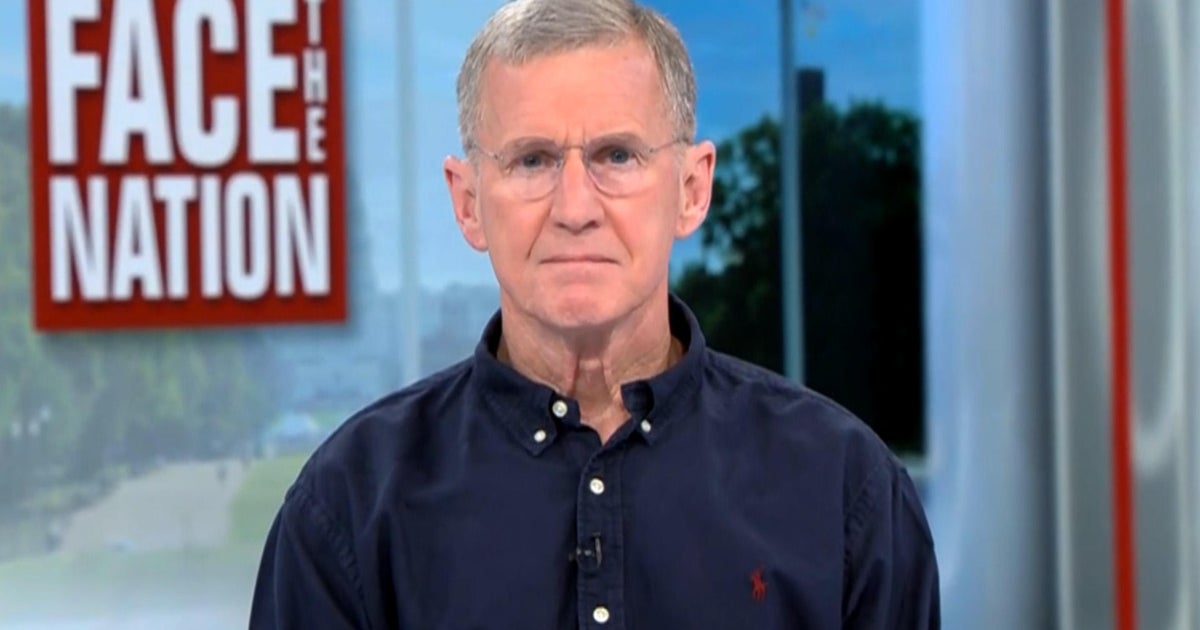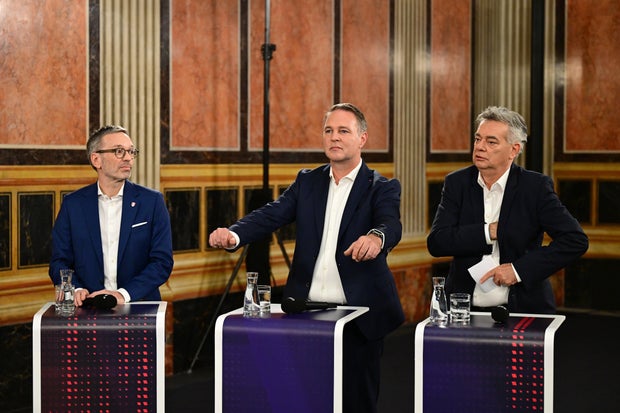CBS News
Could the Fed enact an emergency rate cut before its next meeting? Here are the odds.

The three-day stock market rout roiling Wall Street is prompting some experts to question whether the Federal Reserve could enact an emergency rate cut before its September meeting.
The speculation is arising in the wake of the Fed’s July 31 meeting, when the central bank decided to keep its benchmark rate steady at its highest point in 23 years. At a press conference that day, Fed Chair Jerome Powell said while he and other officials were carefully watching the labor market for signs of weakness, they wanted to see more evidence that inflation was cooling before cutting rates.
But on August 2, the monthly jobs report came in much weaker than expected, sparking fears that the U.S. economy may be fraying under the weight of high borrowing costs and that the Fed has waited too long to cut rates. A few other weak economic reports have added fuel to those worries about the economy, igniting a three-day rout that’s caused the S&P 500 to shed 6% of its value since July 31.
Given the dim economic data, some analysts and investors said they believe the Fed should undertake an emergency cut before their next rate decision, scheduled for September 18.
“Some analysts are even suggesting an intra-meeting emergency cut is warranted,” noted Seema Shah, chief global strategist at Principal Asset Management, in an email.
What are the odds of a Fed emergency rate cut?
Traders are signaling a roughly 60% likelihood of an emergency 0.25 percentage point cut within one week, according to Bloomberg News.
But some experts said they believe the odds are much lower, with Pantheon Macroeconomics noting that overnight index swap rates implied that investors on Monday saw a roughly 30% chance the Fed could make an emergency cut in the next week.
Chicago Federal Reserve President Austan Goolsbee on Monday told CNBC that if there’s more deterioration in economic conditions, “we’re going to fix it.” But he added that even though the jobs numbers were weaker than expected, he doesn’t believe the U.S. is in a recession.
What is the history of Fed emergency rate cuts?
The Fed has cut rates at nine emergency meetings in the last 30 years, which means an intra-meeting cut before September “would not be unprecedented,” Pantheon noted.
The last emergency rate cut was in March 2020, when the economy was free-falling due to the coronavirus pandemic, which shuttered businesses across the globe.
“Intra-meeting cuts have typically only happened in the event of financial crisis,” Shah noted.
That was echoed by Pantheon, which noted that “economic and market conditions usually have been worse than now to trigger an emergency Fed meeting.”
Do economists see an emergency rate cut as likely?
While the markets are pricing in the chance of a rate cut, many economists believe the Fed is likely to wait until its September meeting to start easing borrowing costs, partly as the S&P 500 and Dow Jones Industrial Average remain in positive territory despite the three-day rout.
“We think [Powell] will opt to wait until September, provided markets stabilize,” Pantheon’s economists wrote in a research note. “The Fed probably will place little weight on the drop in stock prices, as the main indexes still are higher than at the start of the year.”
And cutting rates in an emergency meeting might undermine confidence in the economy, Amanda Agati, chief investment officer of PNC’s asset management group, told CBS MoneyWatch.
“From our perspective, this isn’t the environment when you want to hastily throw a rate cut out there,” Agati said. An emergency cut could do “more damage than it helps because then the everyone will say, ‘What does the Fed know that we don’t?'”
CBS News
Cousin of slain Hezbollah leader Hassan Nasrallah emerging as his replacement

Watch CBS News
Be the first to know
Get browser notifications for breaking news, live events, and exclusive reporting.
CBS News
Stanley McChrystal says he is backing Harris because “character is very important”

Watch CBS News
Be the first to know
Get browser notifications for breaking news, live events, and exclusive reporting.
CBS News
Austria’s far-right Freedom Party heading for its first national election win

Austria’s far-right Freedom Party was headed for its first win in a national parliamentary election on Sunday, finishing ahead of the governing conservatives after tapping into voters’ anxieties about immigration, inflation, Ukraine and other concerns, a projection showed. But its chances of governing were unclear.
A projection for ORF public television, based on counting of more than half the votes, put support for the Freedom Party at 29.2% and Chancellor Karl Nehammer’s Austrian People’s Party at 26.3%. The center-left Social Democrats were in third place with 20.5%.
Herbert Kickl, a former interior minister and longtime campaign strategist who has led the Freedom Party since 2021, wants to become Austria’s new chancellor on the back of the first far-right national election win in post-World War II Austria.
But to become Austria’s new leader, he would need a coalition partner to command a majority in the lower house of parliament — and rivals have said they won’t work with Kickl in government.
The far-right has tapped into voter frustration over high inflation, the war in Ukraine and the COVID pandemic. It has also built on worries about migration.
In its election program, titled “Fortress Austria,” the Freedom Party calls for the “remigration of uninvited foreigners,” for achieving a more “homogeneous” nation by tightly controlling borders and suspending the right to asylum via an emergency law.
CHRISTIAN BRUNA / Getty Images
The Freedom Party also calls for an end to sanctions against Russia, is highly critical of Western military aid to Ukraine and wants to bow out of the European Sky Shield Initiative, a missile defense project launched by Germany. Kickl has criticized “elites” in Brussels and called for some powers to be brought back from the European Union to Austria.
“We don’t need to change our position, because we have always said that we’re ready to lead a government, we’re ready to push forward this change in Austria side by side with the people,” Kickl said in an appearance alongside other party leaders on ORF. “The other parties should ask themselves where they stand on democracy,” he added, arguing that they should “sleep on the result.”
Nehammer said it was “bitter” that his party missed out on first place, but noted that he had brought it back from lower poll ratings. He has often said that he won’t form a coalition with Kickl and said that “what I said before the election, I also say after the election.”
More than 6.3 million people aged 16 and over were eligible to vote for the new parliament in Austria, an EU member that has a policy of military neutrality.
Kickl has achieved a turnaround since Austria’s last parliamentary election in 2019. In June, the Freedom Party narrowly won a nationwide vote for the first time in the European Parliament election, which also brought gains for other European far-right parties. The party is a long-established political force but Sunday’s projected result, if confirmed, would be its best yet in a national parliamentary election — beating the 26.9% it scored in 1999.
In 2019, its support slumped to 16.2% after a scandal brought down a government in which it was the junior coalition partner. Then-vice chancellor and Freedom Party leader Heinz-Christian Strache resigned following the publication of a secretly recorded video in which he appeared to offer favors to a purported Russian investor.
The leader of the Social Democrats, a party that led many of Austria’s post-World War II governments, positioned himself as the polar opposite of Kickl. Andreas Babler ruled out governing with the far right and has labeled Kickl “a threat to democracy.”
While the Freedom Party has recovered, the popularity of Nehammer’s People’s Party, which currently leads a coalition government with the environmentalist Greens as junior partners, declined sharply compared with 2019. The Greens’ support also was projected to drop to just under 9%, and the outgoing coalition appeared to be well short of a majority.
During the election campaign, Nehammer portrayed his party, which has taken a tough line on immigration in recent years, as “the strong center” that would guarantee stability amid multiple crises.
But those crises, ranging from the COVID-19 pandemic to Russia’s invasion of Ukraine and resulting rising energy prices and inflation, also cost it support. The government also angered many Austrians in 2022 with a short-lived coronavirus vaccine mandate, the first in Europe.
But the recent flooding caused by Storm Boris that hit Austria and other countries in Central Europe brought the environment back into the election debate and may have helped Nehammer slightly narrow the gap.
The People’s Party is the far right’s only way into government.
Nehammer has repeatedly excluded joining a government led by Kickl, describing him as a “security risk” for the country, but hasn’t ruled out a coalition with the Freedom Party in and of itself — which would imply Kickl renouncing a position in government.
The likelihood of Kickl agreeing to such a deal if he wins the election is very low, leading political scientist Peter Filzmaier said before the election.
The most probable alternative would be an alliance between the People’s Party and the Social Democrats — with or without the liberal Neos, who took about 9% of the vote.








